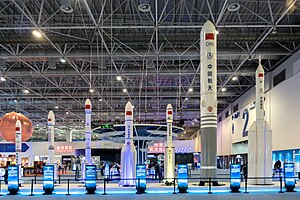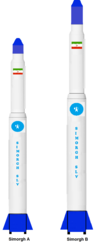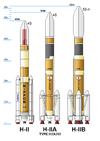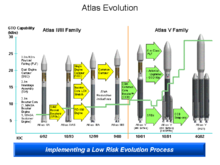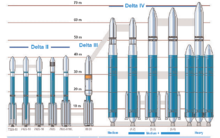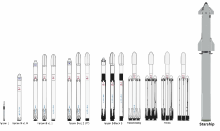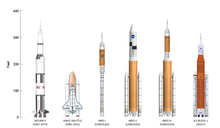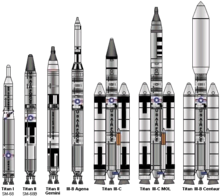
An expendable launch system is a launch vehicle that can be launched only once, after which its components are either destroyed during reentry or discarded in space. ELVs typically consist of several rocket stages that are discarded sequentially as their fuel is exhausted and the vehicle gains altitude and speed. As of 2022, most satellites and human spacecraft are currently launched on ELVs. ELVs are simpler in design than reusable launch systems and therefore may have a lower production cost. Furthermore, an ELV can use its entire fuel supply to accelerate its payload, offering greater payloads. ELVs are proven technology in widespread use for many decades.
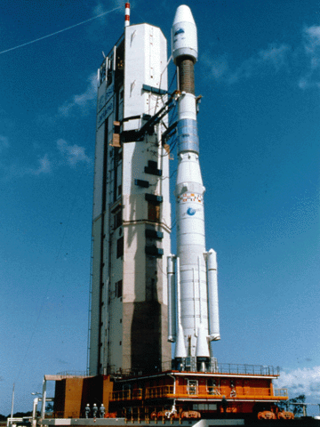
The Ariane 4 was a European expendable launch vehicle, developed by the Centre national d'études spatiales (CNES), the French space agency, for the European Space Agency (ESA). It was manufactured by ArianeGroup and marketed by Arianespace. Since its first flight on 15 June 1988 until the final flight on 15 February 2003, it attained 113 successful launches out of 116 total launches.

A multistage rocket or step rocket is a launch vehicle that uses two or more rocket stages, each of which contains its own engines and propellant. A tandem or serial stage is mounted on top of another stage; a parallel stage is attached alongside another stage. The result is effectively two or more rockets stacked on top of or attached next to each other. Two-stage rockets are quite common, but rockets with as many as five separate stages have been successfully launched.

Geosynchronous Satellite Launch Vehicle (GSLV) is a class of expendable launch systems operated by the Indian Space Research Organisation (ISRO). GSLV has been used in fifteen launches since 2001.

Satish Dhawan Space Centre – SDSC, is the primary spaceport of the Indian Space Research Organisation (ISRO), located in Sriharikota, Andhra Pradesh.

This article outlines notable events occurring in 2005 in spaceflight, including major launches and EVAs. 2005 saw Iran launch its first satellite.
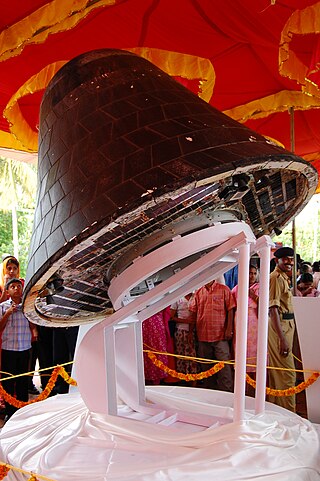
The year 2007 contained several significant events in spaceflight, including a Chinese ASAT test, the launches of the US Phoenix and Dawn missions to study Mars and Asteroid belt respectively, Japan's Kaguya Lunar orbiter, and the first Chinese Lunar probe, Chang'e 1.

This article outlines notable events occurring in 2003 in spaceflight, including major launches and EVAs.

Several significant events in spaceflight occurred in 2009, including Iran conducting its first indigenous orbital launch, the first Swiss satellite being launched and New Zealand launching its first sounding rocket. The H-IIB and Naro-1 rockets conducted maiden flights, whilst the Tsyklon-3, Falcon 1 and Ariane 5GS were retired from service. The permanent crew of the International Space Station increased from three to six in May, and in the last few months of the year, Japan's first resupply mission to the outpost, HTV-1, was conducted successfully.

The year 2010 saw a number of notable events in worldwide spaceflight activities. These included the first test flight of the SpaceX Dragon commercial resupply spacecraft, which is intended to resupply the International Space Station (ISS), and the maiden flights of the Falcon 9 and Minotaur IV rockets. In June 2010, South Korea conducted a second Naro-1 launch, after the failure of the rocket's maiden flight in 2009; however, the second attempt also failed. The Kosmos-3M was retired from service, making its final flight in April. The Molniya-M was also retired from service, making its final flight in September.
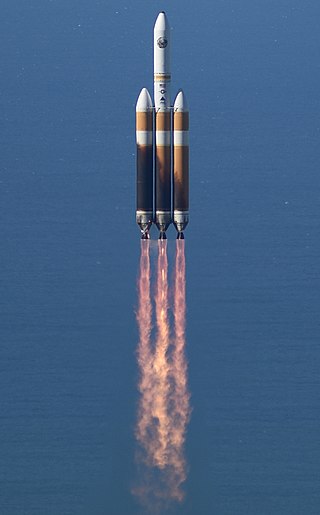
The Delta IV Heavy is an expendable heavy-lift launch vehicle, the largest type of the Delta IV family. It is the world's third highest-capacity launch vehicle in operation, behind NASA's Space Launch System and SpaceX's Falcon Heavy and closely followed by CASC's Long March 5. It was manufactured by United Launch Alliance (ULA) and was first launched in 2004. ULA will retire the Delta IV Heavy in 2024. Future ULA launches will use the new Vulcan Centaur rocket. As of June 2023, one flight remains.

This comparison of orbital launch systems lists the attributes of all individual rocket configurations designed to reach orbit. A first list contains rockets that are operational or in development as of 2023; a second list includes all upcoming rockets and a third list includes all retired rockets. For the simple list of all conventional launcher families, see: Comparison of orbital launchers families. For the list of predominantly solid-fueled orbital launch systems, see: Comparison of solid-fueled orbital launch systems.

The year 2011 saw a number of significant events in spaceflight, including the retirement of NASA's Space Shuttle after its final flight in July 2011, and the launch of China's first space station module, Tiangong-1, in September. A total of 84 orbital launches were conducted over the course of the year, of which 78 were successful. Russia, China and the United States conducted the majority of the year's orbital launches, with 35, 19 and 18 launches respectively; 2011 marked the first year that China conducted more successful launches than the United States. Seven crewed missions were launched into orbit during 2011, carrying a total of 28 astronauts to the International Space Station. Additionally, the Zenit-3F and Long March 2F/G carrier rockets made their maiden flights in 2011, while the Delta II Heavy made its last.

In 2014, the maiden flight of the Angara A5, Antares 120 and Antares 130 took place.

In 2013, the maiden spaceflight of the Orbital Sciences' Antares launch vehicle, designated A-ONE, took place on 13 April. Orbital Science also launched its first spacecraft, Cygnus, that docked with the International Space Station in late September 2013.

This article compares different orbital launcher families. The article is organized into two tables: the first contains a list of currently active and under-development launcher families, while the second contains a list of retired launcher families.

This article documents notable spaceflight events during the year 2019.

Notable spaceflight activities in 2017 included the maiden orbital flight of India's Geosynchronous Satellite Launch Vehicle Mark III on 5 June and the first suborbital test of Rocket Lab's Electron rocket, inaugurating the Mahia spaceport in New Zealand. The rocket is named for its innovative Rutherford engine which feeds propellants via battery-powered electric motors instead of the usual gas generator and turbopumps.
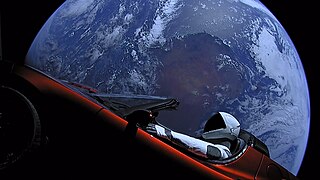
This article documents notable spaceflight events during the year 2018. For the first time since 1990, more than 100 orbital launches were performed globally.
Space launch market competition is the manifestation of market forces in the launch service provider business. In particular it is the trend of competitive dynamics among payload transport capabilities at diverse prices having a greater influence on launch purchasing than the traditional political considerations of country of manufacture or the national entity using, regulating or licensing the launch service.
